[tc_aol_on code=”518823507″]
After months of rumors, Facebook today unveiled “Instant Articles”, a program that natively hosts publishers’ content in its app’s News Feed so users don’t have to click out and wait for websites to load. Instant Articles debuts today with rich-media stories from The New York Times, BuzzFeed, National Geographic, and six other outlets that will be globally visible from Facebook’s iPhone app.
You can check out Instant Articles for yourself by visiting the feature’s Facebook Page on an iPhone. For more on Facebook’s strategy, read our feature piece: Facebook’s Quest To Absorb The Internet.
Assuaging publishers’ fears that Facebook would keep all the data, the social network will share analytics, and Instant Articles is compatible with audience measurement and attribution tools like comScore, Omniture, and Google Analytics. Ads can appear inside Instant Articles, with publishers keeping 100% of revenue if they sell them, and Facebook keeps its standard 30% if it sells the ads, as the Wall Street Journal previously reported.
Instant Articles won’t receive preferential treatment from Facebook’s News Feed sorting algorithm just because of their format. But if users click, like, comment, and share Instant Articles more often than others, they may show up higher and more frequently in feed like any piece of popular content. That could incentivize, or implicitly force, more publishers to adopt the new hosted format.
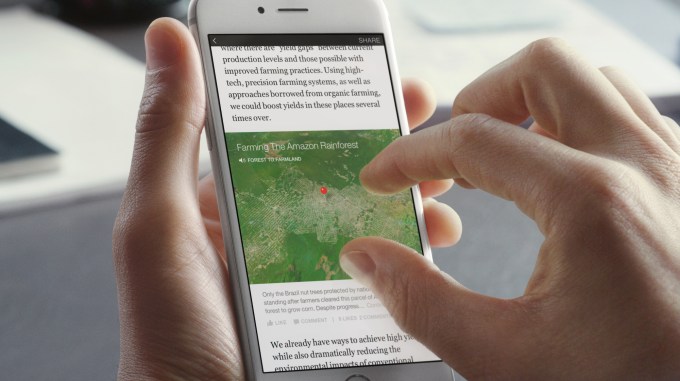
Beyond just loading faster, Facebook will parse HTML and RSS to display articles with fonts, layouts, and formats that make Instant Articles feel like a publisher’s website. But Facebook is also providing vivid media options like embedding zoomable photos, videos, and maps with audio captions, plus contextual ‘Ambient Videos’. Justin Osofsky, the company’s VP Of Global Operations and Media Partnerships, says publishers “can have the same tools that an app developer has. They’re not stuck with what the mobile web can offer.”
If the Instant Articles test is well received, Facebook hopes to add more publishers in the coming weeks with the goal of making it available to any outlet that shares stories on Facebook.
tl;dr – Facebook is trying to plug the holes where users leak out. Slow mobile web article load times lead people to leave its app. Speeding up the reading experience by subsuming it could make sure people stay on Facebook connecting with friends, discovering content, and seeing ads. But the program further indebts publishers to Facebook, and they have to play by its rules.
Designed On Paper
Many think Facebook’s dedicated news reader Paper was a failure because it wasn’t a hit with tens of millions of users. But like Camera, Slingshot, and Facebook’s other standalone apps, it was designed to provide Facebook with insights about user behavior that it could bring back to its main app. This is how Facebook figured out photo filters and stickers, and now Paper has taught it about the stylized reading experience publishers want to provide.
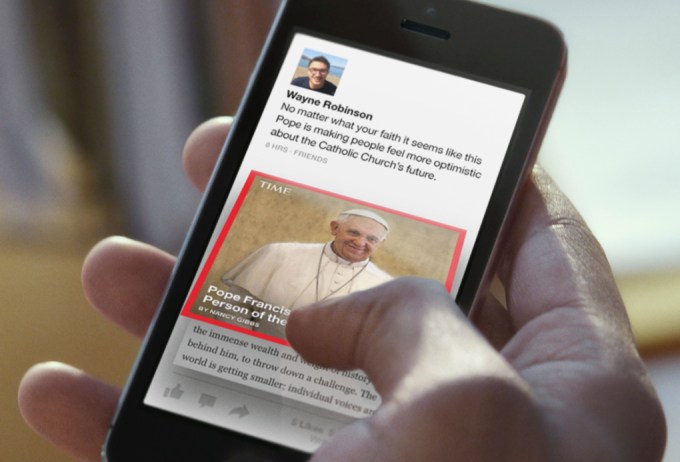
Now, Paper will still be supported, but its team’s leaders including project manager Michael Reckhow and designer Mike Matas are behind Instant Articles. “We’ve brought a bunch of the learnings [from Paper] into this product” Reckhow tells me at Facebook headquarters. That includes stylized cover images and fonts that evoke the publisher’s brand.
The project started with the theses that “speed is often then most important feature of what we build on a mobile phone” Reckhow tells me. The company saw a massive increase in usage and improvement of reviews when it doubled the speed of its iOS app in 2012.
“We have gone through and optimized and sped up all the core experiences of using Facebook: loading News Feed, loading photos, loading videos” Reckhow explains. “The last thing that takes a long time to load in your News Feed is articles.” Matas relays “We’ve all had the frustration of just looking at a blank screen and waiting for something to load”, and notes “On average it takes over eight seconds to load.” That’s an eternity on mobile that causes people to close the app in frustration.
So nine months ago, Facebook devised the plan for Instant Articles. As soon as an Instant Article is algorithmically picked to show up in the News Feed, a rich cover image and the article itself is pre-loaded into Facebook’s native app.
When you tap one, instead of having to wait for an internal browser window opening the website to load, the screen slides over immediately revealing the hosted content. Matas says they load “about 10x faster than the mobile web”, and in my demo on Wi-Fi, it took just a quarter-second or so. Not enough time to get bored and leave Facebook.
Built To Appease Publishers
In August, the Instant Articles team began meeting with top publishers. It knew they’d be edgy about shifting the reading experience off their website and to Facebook. Osofky tells me “We thought it was important to get feedback from publishers directly, and then build to meet their needs.”
After hearing their pitch, BuzzFeed’s VP Of Product Chris Johanesen told the Instant Articles team “Great meeting, you but here are the seven things that we would need to be able to do this program”, a BuzzFeed spokesperson tells me. Those requests were:
- Compatibility with comScore traffic measurement
- Compatibility Google Analytics to understand the audience
- To make sure Google Analytics worked across all its content
- Compatibility with BuzzFeed’s internal analytics tools
- Control of design to make Instant Articles look and feel like BuzzFeed articles
- Ability to work with BuzzFeed on special formats like quizzes
- Monetization
When Facebook returned in January, BuzzFeed’s spokesperson tells me “I gotta say, it was pretty impressive. ‘Those things you asked for? We’re going to do all of them.’”
As it launches today, Instant Articles will work with comScore to properly attribute traffic to publishers, though others like Quantcast or Compete may not be totally accurate yet. Google Analytics, Omniture, and some publishers’ tracking tools will work just like on a publisher’s websites, recording standard data on who’s looking at what articles and the media inside them.
Facebook plans to expand the analytics for publishers tools it released in December, which can tell outlets how far users scrolled. Still, Osofsky notes “We’ll always respect the privacy of people and personally identifiable information will never be shared.”
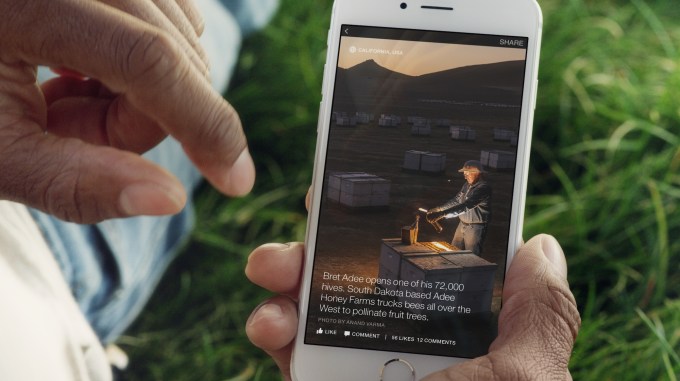
From the moment users see an Instant Article’s story blurb in the News Feed, it will look distinctly theirs. The New York Times and BuzzFeed’s iconic fonts will shine through, as will National Geographic’s yellow border. Instant Articles support all kinds of embeds like tweets and YouTube videos, as well as web views to allow even more rich content flexibility like interactive infographics.
Facebook’s main goal is improving the News Feed experience so people stay longer and see the highly-lucrative ads it already shows, not to steal ad impressions from publishers. So publishers will retain control of what ads they choose to show inside the Instant Articles. If they sell them, they’ll keep 100% of the revenue. If Facebook sells the ads through its Audience Network mobile ad network, it will keep 30% and give 70% to the publisher.
And publishers aren’t bound to use the product. Partners can publish as many or as few Instant Articles as they want, and display and promote those same articles elsewhere however they want. No exclusivity.
It has felt extremely collaborative from the beginning BuzzFeed
But none of this would matter if it was hard to turn what publishers already product into Instant Articles, because they’d never adopt the format. Reckhow explains that Facebook built a “bridge” that parses the HTML and RSS of articles publishers post, and converts them into Instant Articles. Enabling the rich media tool like audio captions takes just a single extra line of code or tag.
Working with Facebook “has felt extremely collaborative from the beginning” BuzzFeed tells me. That’s a far cry from the worries most publishers had about Facebook strong-arming them into exploitative hosted content deals.
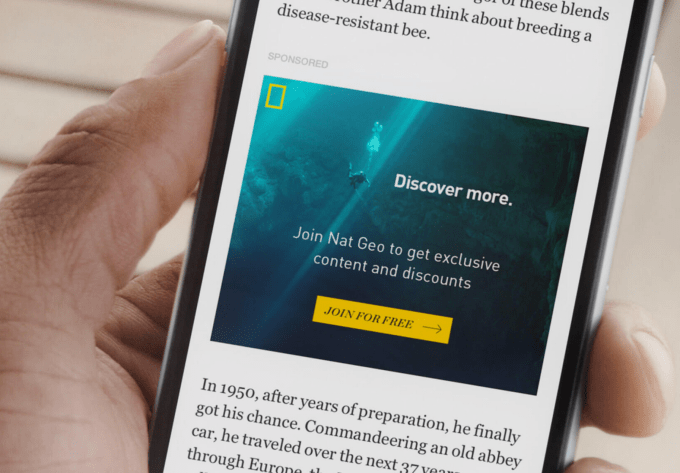
Mobile-First News
Instant Articles offers perhaps the richest mobile news reading experience today. Everything is designed to react to where users scroll, instantly play without extra taps, and be navigatable by touch or tilt.
Today, one Instant Article will be posted by each of the nine launch partners: The New York Times, The Atlantic, NBC News, National Geographic, and BuzzFeed in the US; The Guardian and BBC News in the UK; and Spiegel and Bild in Germany. The posts will appear from their respective Facebook Pages in Instant Article format to iPhone users around the world, with Android version likely forthcoming. The post will also be collected on Facebook’s special Instant Articles Page. Those on the desktop or mobile web, Android, or other platforms will see the same links on the publishers’ websites formatted like normal.
In this video, Facebook Chief Product Officer Chris Cox introduces Instant Articles
Publisher-branded cover images greet users as they scroll through the feed, beckoning their taps. These covers can even use the autoplay video format that was Facebook’s big hit of 2014. Though the News Feed’s algorithm won’t play favorites, readers might. The animated Instant Article covers are certainly more eye-catching than traditional static blurbs, and those clicks tell the feed to show a story to more people.
Inside Instant Articles, the design can be remarkably slick if publishers take advantage of Facebook’s vivid media options. Matas says “We wanted to give publishers tools to make the in-article experience really rich and interactive.”
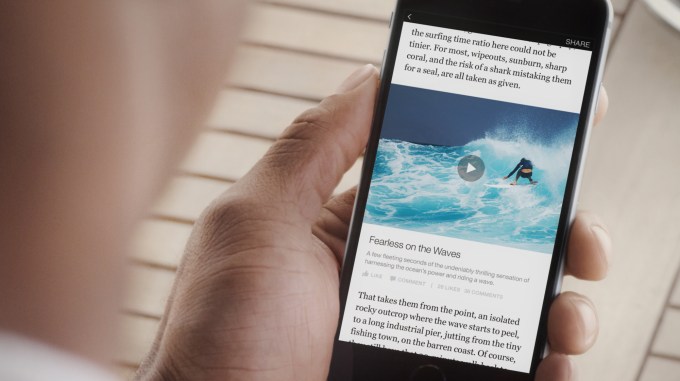
Publishers can feature the Facebook profiles of their authors and writers so readers can easily follow them. The featured image at the top can be an autoplay video with sound. What Matas calls “ambient videos”, essentially little clips that subtly add context and look like moving pictures, can be peppered throughout. Maps, photos, and galleries can feature audio captions that automatically play when you’re viewing that part of the post and fade out as you scroll by.
Most any kind of media can be viewed full screen or zoomed, and you can tilt your phone back and forth to pan around — another feature cribbed from Paper. Individual pieces of media can even be shared, commented on, or Liked. If friends open your share inside Facebook for iPhone, it will open the Instant Article. Otherwise, friends will be sent to the publisher’s site as usual.

Referral Addicts
Over the years, Facebook has become a juggernaut of referral traffic for publishers. So much so that they’re understandly concerned about how Instant Articles could impact their businesses. Facebook contributes more than Google to many, and dwarfs that of Twitter.
“We were wary when Facebook first approached us about this opportunity last year. But the more we talked with their team, the more comfortable we became” The Atlantic’s president and COO Bob Cohn tells me. “We believe the hosting program will help us reach a bigger audience yet…And since we are able to sell ads into the Facebook template, and keep all of that revenue, we’re building our business.”

Outlets will certainly cede some control to the social network, and risk dilluting their brand if users think they can just go to Facebook and not regularly visit their site. They may miss some flexibility, or just generally feel odd about letting their content outside its cage. Recirculation promos for their other posts could be hidden by the minimalist Instant Articles format.
All these issues make it harder to convert casual visitors from social into heavy readers or paid subscribers, which are the whales of the news business.
Plus there’s always the nightmare that Facebook adjusts the terms to squeeze publishers down the line in the name of improving the user experience. It’s moved to tax and reduce virality for game developers dependent on it in the past. The new format could further addict publishers to Facebook, giving it the leverage of a street pusher. It gives publishers faster access to readers for free if they sell the ads today. What about tomorrow?
 But mobile is a new era. Not just for news. For everything. Yet publishers have become trapped in the weak, outdated mobile browser. Instant Articles offer them the chance to modernize with the power of native apps without having to build them themselves. And Facebook designed the product in a way that gives publishers most of what they need, even if it’s not everything they want.
But mobile is a new era. Not just for news. For everything. Yet publishers have become trapped in the weak, outdated mobile browser. Instant Articles offer them the chance to modernize with the power of native apps without having to build them themselves. And Facebook designed the product in a way that gives publishers most of what they need, even if it’s not everything they want.
Facebook’s on a quest to bar the exits to its app and keep users bouncing around its endless stream of content and ads. Publishers can cooperate and come inside, or risk being left out.





























Comment